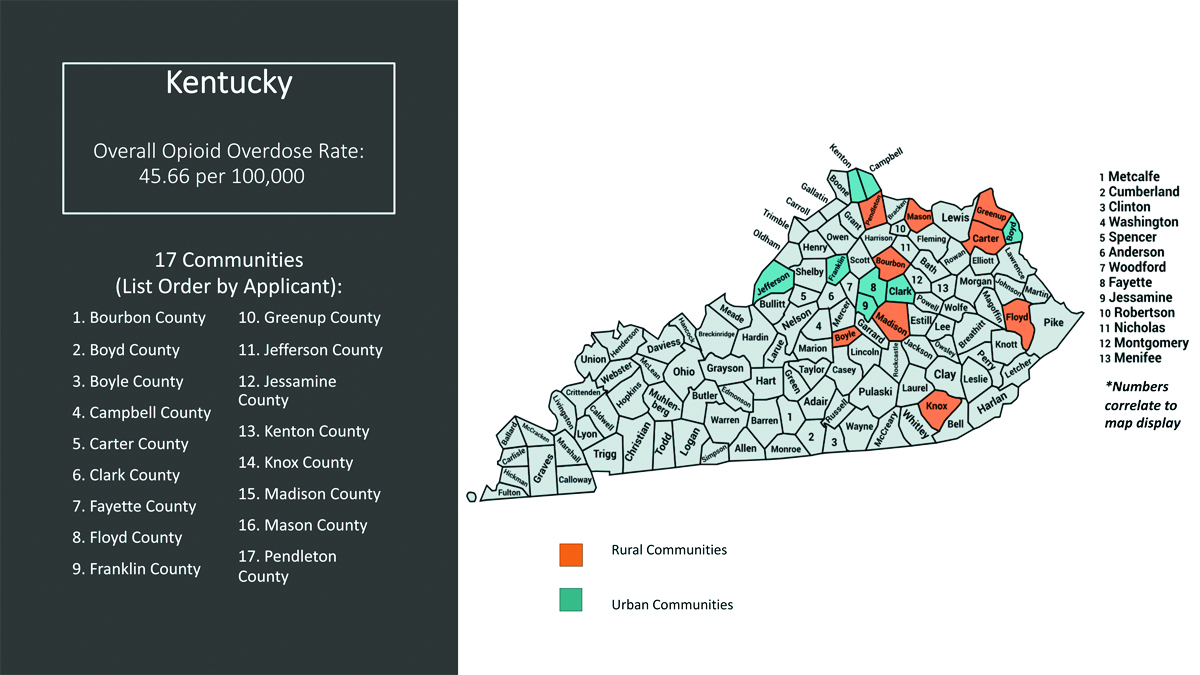
20 Apr Clark to benefit from $87M opioid epidemic grant – Winchester Sun
Clark County will be a part of a federal-funded University of Kentucky study tasked with decreasing opioid-related deaths.
In the largest grant ever awarded to the University of Kentucky, researchers from UK’s Center on Drug and Alcohol Research in partnership with the Kentucky Cabinet for Health and Family Services and the Justice and Public Safety Cabinet will lead the project as part of the HEALing Communities study, according to a press release issued Thursday.
Clark is one of 16 counties participating in the four-year, more than $87 million study, with “an ambitious but profoundly important goal: reducing opioid overdose deaths by 40 percent in 16 counties that represent more than a third of Kentucky’s population,” according to the release.
NIH and SAMHSA (Substance Abuse and Mental Health Services Administration) launched the HEALing Communities Study to prevent and treat opioid misuse and opioid use disorder within highly-affected communities in four states and reduce opioid-related deaths by 40 percent over three years, according to the NIH website.
More than 47,000 Americans died of an opioid overdose in 2017.
In Kentucky, the overall opioid overdose rate is 45.66 per 100,000, according to the NIH.
The problem runs deep, according to the press release — “More than 2 million Americans live with addiction to opioids. Life expectancy in this country has dropped — fueled, in large measure, by drug overdose deaths. Kentucky currently is ranked fifth in the United States for opioid overdose deaths and has suffered through the opioid epidemic since its inception.”
“Not only are these staggering figures likely underestimated, they also fail to capture the full extent of the damage of the opioid crisis, which reaches across every domain of family and community life — from lost productivity and economic opportunity, to intergenerational and childhood trauma, to extreme strain on community resources, including first responders, emergency rooms, hospitals and treatment centers,” the release states.
UK researchers are hoping to reduce deaths and substance abuse by leveraging existing community resources and initiatives to deploy a robust and comprehensive set of evidence-based interventions.
Sixteen counties in Kentucky that are “highly affected communities” have been identified to be included in the randomized study.
They include Fayette, Jessamine, Clark, Kenton, Campbell, Mason, Greenup, Carter, Boyd, Knox, Jefferson, Franklin, Boyle, Madison, Bourbon and Floyd counties.
“Overall, these rural and metropolitan counties had 764 opioid overdose deaths in 2017 with two-thirds of them involving fentanyl,” the release states. “They also represent about 40 percent of the state’s overall population of more than 4 million people.”
Researchers will work closely with community coalition partners to ensure a community-centered approach and to maximize engagement. In addition, a comprehensive health communication strategy will be used to reach the public, reduce stigma and increase awareness of — and access to — the interventions available through the program.
In Clark County, two local agencies — the Clark County Health Department and the Clark County Agency for Substance Abuse Policy — are partnering with UK for the initiative.
ASAP Coordinator Melissa Stocker said the money will be used to address the multi-faceted opioid addiction issues in the community.
“The Clark County ASAP is excited to be one of the 16 counties selected to participate in this grant,” Stocker said in an email Friday. “We look forward to working with UK and having the opportunity to help make a difference in our community. There is still a lot of work to be done, but myself and the other community partners are up for the challenge.”
She said the approach will be broad-reaching.
“While there is still a lot to unpack and work on, areas will include education, prevention, and treatment, i.e. care coordinators, prevention specialist, and possibly even working with the local jailer, probation and parole officers,” she wrote.
“By implementing the ‘multi-level, multi-target, integrated evidence-based interventions’ in the highly-affected communities selected in the study, researchers hypothesize opioid OD deaths could be reduced by as much as 40 percent,” according to the release.
The study’s aims also include:
— Improving and expanding opioid use disorder (OUD) treatment by increasing the use of medications in treatment,
— Expanding overdose (OD) prevention by increasing OD training, naloxone distribution and fentanyl test strip distribution for individuals at high risk for opioid OD, and
— Reducing the opioid supply by decreasing high-risk opioid prescribing and dispensing practices through targeted education and increasing safe disposal of unused opioids.
[ad_2]
Source link



No Comments